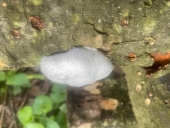Thanks Greg,
I think you figured it out. Date plum (diospyros lotus). I looked up a couple other videos on youtube and found some that had a look more similar to mine as far as the skinny acorn like shape.
What he says is true about the astringency. They should be dark and a little shriveled to eat.
Im still curious if any on my other trees will turn out this way and if I got this from the bundle of persimmon trees or from seed or was just a rootstock. I think at at some point I also had a packet of date plum seeds from tradewinds fruit.
It's nice knowing the variety if I have to look something up or someone else wants to know the type.









